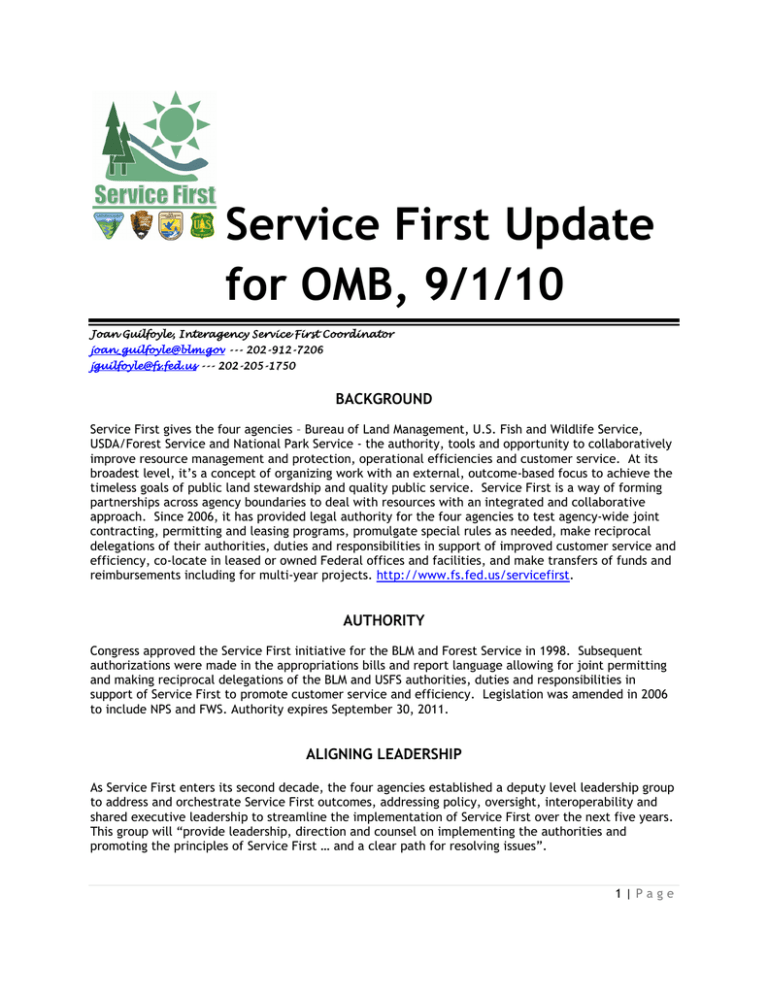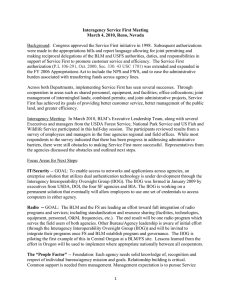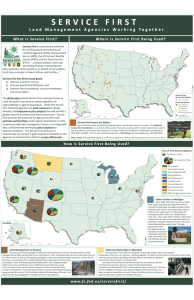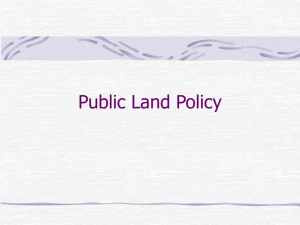Service First Update for OMB, 9/1/10 BACKGROUND
advertisement

Service First Update for OMB, 9/1/10 Joan Guilfoyle, Interagency Service First Coordinator joan_guilfoyle@blm.gov --- 202-912-7206 jguilfoyle@fs.fed.us --- 202-205-1750 BACKGROUND Service First gives the four agencies – Bureau of Land Management, U.S. Fish and Wildlife Service, USDA/Forest Service and National Park Service - the authority, tools and opportunity to collaboratively improve resource management and protection, operational efficiencies and customer service. At its broadest level, it’s a concept of organizing work with an external, outcome-based focus to achieve the timeless goals of public land stewardship and quality public service. Service First is a way of forming partnerships across agency boundaries to deal with resources with an integrated and collaborative approach. Since 2006, it has provided legal authority for the four agencies to test agency-wide joint contracting, permitting and leasing programs, promulgate special rules as needed, make reciprocal delegations of their authorities, duties and responsibilities in support of improved customer service and efficiency, co-locate in leased or owned Federal offices and facilities, and make transfers of funds and reimbursements including for multi-year projects. http://www.fs.fed.us/servicefirst. AUTHORITY Congress approved the Service First initiative for the BLM and Forest Service in 1998. Subsequent authorizations were made in the appropriations bills and report language allowing for joint permitting and making reciprocal delegations of the BLM and USFS authorities, duties and responsibilities in support of Service First to promote customer service and efficiency. Legislation was amended in 2006 to include NPS and FWS. Authority expires September 30, 2011. ALIGNING LEADERSHIP As Service First enters its second decade, the four agencies established a deputy level leadership group to address and orchestrate Service First outcomes, addressing policy, oversight, interoperability and shared executive leadership to streamline the implementation of Service First over the next five years. This group will “provide leadership, direction and counsel on implementing the authorities and promoting the principles of Service First … and a clear path for resolving issues”. 1|Page SERVICE FIRST LEADERSHIP TEAM Mike Pool Joel Holtrop Daniel Wenk Greg Siekaniec Deputy Director, Operations, Bureau of Land Management Deputy Chief, National Forest System, USDA Forest Service Deputy Director, Operations, National Park Service Assistant Director, National Wildlife Refuge System, U.S. Fish and Wildlife Service IT SECURITY/RADIO COMMUNICATIONS The Interdepartmental Interoperability Oversight Group (IIOG) was formally chartered in 2009 to enable the agencies to meet the goals of Service First. It is committed to the development and fostering of interoperable network and land mobile radio communications between and among the land managing agencies of the Department of the Interior and the USDA Forest Service to meet the program and mission requirements of those agencies. Operating at the executive level, the IIOG is comprised of chief information officers and program managers who have the authority and responsibility to commit resources to establish strategic solutions, resolve policy and technical barriers, and integrate among agency and program governance organizations. The IIOG envisions and strives to accomplish interoperability solutions that integrate existing voice and data networks to provide transparent and seamless communications, services and access to data by agency program users. The IIOG seeks solutions that share agency resources and capabilities rather than solutions that merely provide user connectivity. For example, the IIOG has drafted for USDA and DOI signature a MOU that “improves the effectiveness and efficiency in attaining our mission goals by recognizing each other’s ability to perform identity management, authentication and credentialing”. This reciprocity will aid in the use of interagency equipment, facilities and resources, as appropriate, to accomplish agency missions, including: integrated telecommunications, email, systems architecture, GIS, records management, Internet and Intranet pages, and application deployment that supports the use of shared systems and processes. It will provide common multi-agency computer access to bureau and agency IT systems, achieve a significant level of sharing of agency Network resources, and enable seamless data sharing across the agencies and bureaus. SOME SELECT FIELD SUCCESS STORIES Dual-delegated unit in the San Luis Valley, Colorado The San Luis Valley Public Lands Center is a Service First, dual-delegated unit. All line officers are dual-delegated having both FS and BLM management authorities/responsibilities. All units are made up of blended staff. One unit also has an FWS Ecological Services staff member that provides technical assistance and, on some projects, is an ID team member. We share personnel and resources with San Luis Valley National Wildlife Refuge Complex (FWS) and the National Park Service’s Great Sand Dunes National Park and Preserve. The agencies have received compliments from the public because they can obtain a variety of BLM and/or FS permits and information from one source through our Visitor Information Services staff. Because they have a blended staff working on travel/access management, they have been able to ensure that our road systems and designations align so we are not creating additional problems for the public. 2|Page By integrating staff, budget, and other resources, the office has been able to share resources and scare skills to manage the organization more effectively. This has saved or better utilized about 10 FTE by adding to the capacity of one agency or the other to complete priority projects. Either agency can purchase expertise from the other; eliminating the need for each agency to have all expertise on staff. Service First has allowed the office to manage natural resources on a landscape level and utilize the unique capabilities and talents of each agency. The public receives one-stop business model that improves customer service. In addition, dual-delegation naturally creates cross-boundary thinking among decision makers. Combined Human Resources office in Anchorage, Alaska The Alaska Combined Human Resources Service Center was established as a pilot program in 2007 under the auspices of Public Law 106-291, as amended and Public Law 109-54, Title IV, Section 428, known as Service First. The purpose is for the BLM and FWS offices in Alaska to cooperate in an Administrative Service Center designed to improve the delivery of administrative services, reduce duplication and take advantage of the best practices of each agency. The Combined Center consists of two units, organized by human resource function. The staffing function is located in the BLM Alaska state office in downtown Anchorage. The classification and employee relations function is located at the FWS Regional Office, in midtown Anchorage. Both units are cross-delegated and comprised of blended staff. The combined center provides all aspects of HR services for approximately 1,500 employees of both organizations. Although the combination has not resulted in savings of FTEs, using the strengths of the whole allows the bureaus to meet the HR needs and goals of the organizations more effectively, where those needs may not previously have been met by the independent offices. The offices maintain a shared HR website, which is available to employees from both bureaus that provides and use the same software, which improves the job application process. The combined center staff has also been introduced to and become more familiar with the culture and mission of each agency enabling them to develop a deeper understanding of the HR needs in each organization. BLM and NPS co-managed unit in Arizona The Grand Canyon-Parashant National Monument was established by presidential proclamation on January 11, 2000. The proclamation stated that BLM and NPS had joint management responsibilities for the monument. It was envisioned as a new model for national monument management; lands that would be managed as a hybrid of traditional BLM multiple use management and traditional NPS monument management. Through strong coordination and sharing responsibilities, this integrated organization has evolved to a BLM monument manager and a NPS superintendent jointly managing the monument (without assistant managers). Each supervises an integrated staff of NPS and BLM employees. A new interagency agreement citing Service First authority is being drafted. San Juan Public Lands, Colorado The San Juan Public Lands Center (SJPLC) is a Forest Service and BLM integrated unit with line managers delegated the authority to act for both agencies across 2.6 million acres of National Forest and BLM system public lands in southwestern Colorado. FS and BLM employees are co-located in five offices across the unit – at the SJPLC headquarters, three ranger district/field offices, and the BLM Canyons of the Ancient National Monument at the Anasazi Heritage Center. The SJPLC strives to 3|Page manage this entire landscape seamlessly across jurisdictions to improve land health, oversee multiple use activities consistently, provide better service to the public, and save money. For example, the integrated organization facilitates timely, coordinated resource management and restoration of large landscapes and watersheds like the Dolores and Animas rivers, since the San Juan jointly administers much of both the headwaters and downstream reaches. Administration of significant oil and gas activity on both agencies lands is greatly enhanced by an integrated organization. The San Juan routinely conducts joint landscape NEPA analyses and issues single decisions for both BLM and NFS lands. Visitor information for both agencies is completely integrated on the web and at five public contact locations in southwest Colorado. Feedback from our local communities, permittees and the visiting public is very positive about Service First primarily because it offers the public “one-stop shopping.” Southern Nevada Agency Partnership (SNAP) The four Service First agencies manage a combined 10 million acres of land surrounding Las Vegas, Nevada, and have worked together for more than a decade as the Southern Nevada Agency Partnership (SNAP). SNAP has created a solid forum through which common opportunities and concerns can be addressed in the context of a larger landscape, across agency boundaries. Service First authorities have facilitated ongoing cooperation through engaged leadership and empowered staff. In recent years, funding from the sale of federal land in the area has supported work of the SNAP Board of Directors and 14 interagency teams. Together, SNAP team work to remove desert dumpsites, reduce theft and vandalism of cultural resources, share GIS data, control invasive species, better manage OHV use, address priority science and research needs, engage volunteers in stewardship, introduce new generations to the natural world and their cultural heritage, and collaboratively address other shared concerns. SNAP will need continued Service First authorities and tools to complete current projects and to undertake new ones. Some of their accomplishments include: • The SNAP Interagency Law Enforcement/Resource Protection Team serves as a national model with cross-delegation authority that allows each of the four agencies to patrol on the other’s land. This has allowed faster response to emergencies, “saturation” patrols at problem areas, and enhanced resource protection for all of the agencies. A Special Assistant U.S. attorney and special agents on the team have helped move cases through the Federal court system, with convictions for resource damage. • The SNAP Wilderness Team developed the first interagency Wilderness Management Plan in the Nation for the BLM/NPS-managed Muddy Mountains Wilderness. Based on this model, eight additional interagency wilderness plans are also being developed. A Service First agreement between USDA/FS, NPS and BLM for cadastral survey services enabled the completion of legal boundary descriptions and maps for all 18 wilderness areas designated in 2002 (PL 107-282). Fire and Service First The wildland fire community has a long history of effectively using wildland fire resources to manage other emergency response incidents. This capability contributes to the overall complexity facing them today. The wildland fire program is the seamless integration of personnel and equipment that holds the key to successful and efficient use of firefighting resources. This highly integrated workforce relies on Service First in the Northwest Geographic area to provide the leadership and workforce as a single 4|Page force in the management of wildland fire incidents. This organization has provided the rest of the wildland fire and incident command communities with a highly successful model for future changes. 5|Page





